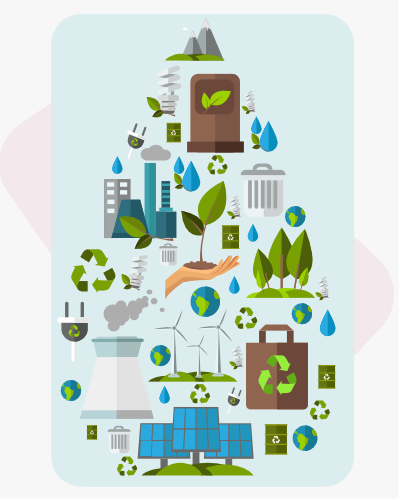Environmental Solutions
In response to the escalating environmental challenges, BioBiz is committed to offering sustainable solutions that address land, air, and water pollution. We recognize the immediate need for actionable strategies that not only alleviate these issues but also contribute to the long-term health and resilience of our planet.

Our environmental solutions provide numerous benefits, such as

Reduced Pollution
By adopting our sustainable strategies, businesses can decrease their environmental footprint, leading to reduced pollution levels in the air, land, and water.

Enhanced Sustainability
Our solutions are designed to foster long-term sustainability, ensuring that the strategies we provide are not merely temporary fixes but lasting solutions.

Improved Public Image
By taking proactive steps towards environmental sustainability, businesses can enhance their public image and foster stronger relationships with customers, stakeholders, and the community.
At BioBiz, we are dedicated to providing innovative and effective environmental solutions that help businesses and organizations contribute to a cleaner, healthier, and more sustainable future.
Prominent Solution Domains:
Our environmental solutions span across various domains, including:
Land Pollution: We offer strategies to reduce soil contamination and promote sustainable agricultural practices
Air Pollution: Our solutions aim to minimize harmful emissions and promote cleaner air quality.
Water Pollution: We provide strategies to protect water bodies from contamination and promote sustainable water use
Latest Trends
A significant development in the realm of environmental solutions encompasses the incorporation of digital technologies for immediate monitoring and data-informed decision-making processes. The deployment of intelligent environmental surveillance systems, which harness the power of sensors and artificial intelligence, equips regulatory bodies and local communities to proactively tackle pollution origins. Furthermore, the implementation of nature-based strategies, encompassing green infrastructure and restoration initiatives, signifies a trend that emphasizes the balanced interaction of human activities with the natural environment. These trends highlight the dynamic and continually evolving characteristics of environmental solutions in the quest for a more pristine and healthier planet.
Detailed Impacts:
Air Pollution
Industrial emissions and vehicular exhaust are major sources of air pollution, posing respiratory risks and degrading overall air quality. Harmful pollutants, including particulate matter and gases, contribute to health issues and environmental degradation, necessitating comprehensive air quality management.
| Solution | Description | Application |
| Microbial Volatile Organic Compounds (MVOCs) Treatment | Certain microorganisms, such as bacteria and fungi, release volatile organic compounds that can neutralize or break down pollutants. | Introduce specific microbes that produce beneficial MVOCs in indoor environments or industrial settings to improve air quality |
| Bioaugmentation | Augmenting the microbial population in a given environment with specific microorganisms capable of degrading or transforming pollutants. | In industrial settings or areas with high pollution levels, introduce engineered or naturally occurring bacteria that can metabolize pollutants. |
| Moss and Algae Biofilters | Moss and algae can absorb and filter pollutants from the air. | Implement vertical moss walls or algae-based biofilters in urban areas or near industrial sites to capture particulate matter and improve air quality. |
| Bio-scrubbers | Use of biologically active materials (such as compost or peat) to absorb and neutralize pollutants from air streams | Install bio-scrubbers in industrial exhaust systems to capture and treat pollutants before release. |
| Phage-Mediated Biocontrol | Bacteriophages (viruses that infect bacteria) can be used to control harmful bacteria that contribute to air pollution. | Employ bacteriophages in environments where bacterial emissions contribute to air quality issues, such as waste treatment facilities. |
| Mycorrhizal Fungi-Assisted Phytoremediation | Mycorrhizal fungi form symbiotic relationships with plants, enhancing their ability to absorb nutrients and pollutants from the soil. | Introduce mycorrhizal fungi to the root systems of plants in urban environments or areas with contaminated soil to improve plant health and air quality. |
| Biological Activated Carbon Filters | Use activated carbon filters with a microbial biofilm to adsorb and biodegrade volatile organic compounds (VOCs). | Employ these filters in ventilation systems and industrial processes to remove VOCs from air streams. |
| Biological Oxidation of Sulphur Compounds | Certain bacteria can oxidize sulphur compounds, reducing the presence of sulphur-containing pollutants. | Implement biological oxidation processes in industries emitting sulphur compounds, such as those in the petrochemical sector. |
Soil Pollution
Industrial waste and agrochemicals contribute to soil pollution, jeopardizing agricultural productivity and ecosystem health. Contaminants can alter soil composition, affecting plant growth and posing threats to human health through food chain contamination.
| Solution | Description | Application |
| Mycorrhizal Soil Remediation | Fungi, such as oyster mushrooms, are used to break down and absorb contaminants in soil. | Apply mycoremediation in areas with soil contamination from industrial discharges or chemical spills |
| Phyto-stabilization with Hyperaccumulator Plants | Specific plants, known as hyperaccumulators, absorb and accumulate heavy metals from soil. | Plant hyperaccumulator species in areas with soil contaminated by heavy metals, aiding in the extraction and concentration of pollutants. |
| Bioventing for Soil Vapor Extraction | Use microorganisms to enhance the degradation of volatile organic compounds (VOCs) in the soil by promoting aerobic conditions. | Apply bio venting in sites contaminated with VOCs, such as former industrial facilities, to enhance soil vapor extraction. |
| Land Farming with Microbial Activity | Utilize microbial activity in the soil to degrade organic pollutants in land farming systems. | Implement land farming in agricultural areas or sites with hydrocarbon-contaminated soil for the biological breakdown of pollutants. |
Water Pollution
Industrial discharges and urban runoff contribute to water pollution, endangering aquatic ecosystems and human health. Chemical pollutants, nutrients, and pathogens can disrupt water quality, impacting biodiversity and necessitating sustainable water management practices.
| Solution | Description | Application |
| Denitrifying Bioreactors | Employ denitrifying bacteria to convert nitrates in agricultural runoff into nitrogen gas, reducing nutrient pollution | Install denitrifying bioreactors in drainage systems receiving agricultural runoff to mitigate nutrient loading in water bodies. |
| Bioaugmentation | Introduce specific bacteria or microbial consortia into bioremediation ponds to enhance the breakdown of pollutants in wastewater, and ocean for oil spills | Employ bioaugmentation in large-scale treatment systems for industrial effluents or municipal wastewater, to accelerate the degradation of oil in water bodies. |
| Floating Wetlands and Bio-Mats | Construct floating wetlands with vegetation and microbial mats that absorb and transform pollutants in water. | Deploy floating wetlands in water bodies like lakes or ponds to improve water quality and support biodiversity. |
| Bioelectrochemical Systems (BES) | Microbes are used in BES to catalyze reactions that promote the removal or transformation of pollutants while generating electricity. | Apply BES technology in wastewater treatment plants to simultaneously treat water and generate energy. |
| Bacterial Biodegradation in Contaminated Aquifers | Introduce bacteria capable of breaking down specific contaminants into groundwater aquifers to remediate groundwater pollution. | Implement bacterial biodegradation in areas with underground contamination from industrial spills or leaking storage tanks. |




 99529 10083
99529 10083 consult@eai.in
consult@eai.in